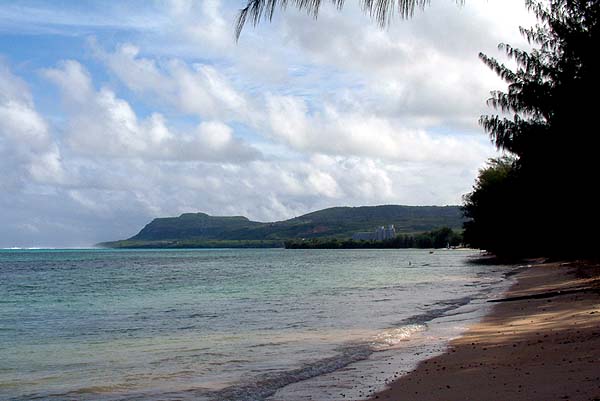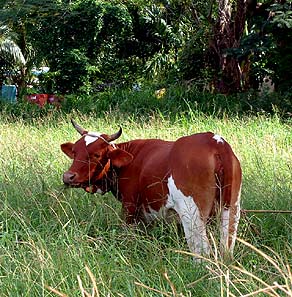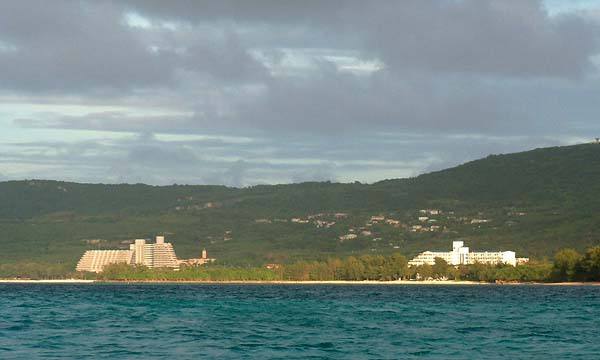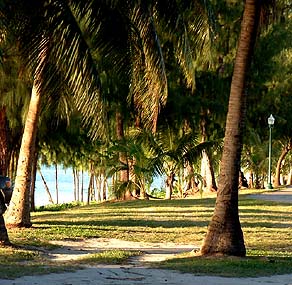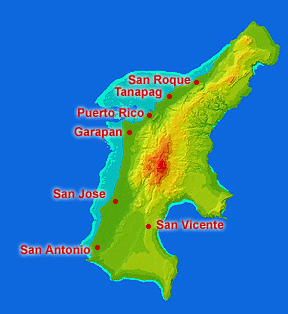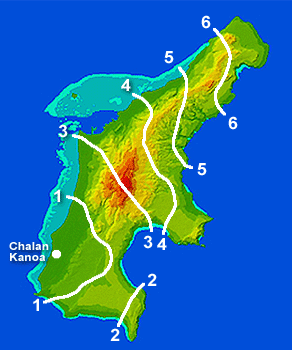 |
 |
 |
|||||
|
|
|
|
|
|
|
|
|
|
|
|||||||
| |
|
|
|
“To the north of the village, the first neighboring area—it wasn’t a village then, it was just sparsely populated, maybe three, four houses,” Ben recounts. “That is Achugao. And immediately after Achugao is the village of Matansa."
|
||
|
|
||
“The Spanish word matansa means ‘to slaughter.’ During the Japanese time or German time, to slaughter an animal, like a cow or pig, you had to bring it to Matansa to do it. You are permitted to slaughter there; otherwise, you can’t just slaughter any where. Sanitation was originally the main factor for this rule, I guess, and making sure you didn’t kill someone else’s animal, to prevent people from stealing. "At one time it was quite common to tender your cow around this area and the next day your animal would be gone and you wouldn’t know who did it. Tinian went through the same scenario today. You’ve got to have a permit to kill a cow."
|
|
|
“Today the neighboring village up north of us is called San Roque,” Rosa explains, “but during the Japanese time, it was called Matansa, and there are relatives of mine up there next to San Roque. My sister lives up there, married to a Camacho family. Her name is Rosario Omar. The majority of the people are Chamorro: Camacho, Lisama, Babauta, Mafnas, those names.” “It’s mostly Chamorro up there,” Ben adds, “We have no clan connections there. San Roque is a Catholic renaming of the village” Ben says. “San Roque’s original name is Matansa. Only later did they change the name.”
|
|
|
|
|
“The influence of the Roman Catholics has changed a lot of things with the local people of Saipan, and the rest of the Northern Marianas. Matansa is the olden-days name of the village of San Roque. There’s a patron saint there called Saint Roque."
|
||
|
|
||
“Oleai is another example,” says Mrs. Louisa Sablan. “It’s named after those Carolinians that came from the island of Woleai. Woleai is an outer island of Yap. Those are the Carolinians that came from that place. So what is now Oleai actually is Woleai.” “There have been several attempts made by some of our leaders to change the name from Oleai to the Christian name of San Jose,” Lino adds. “So both names continue to exist today: San Jose village and Oleai village. San Jose is the new name that was given by our leaders.”
|
|
|
“Tanapag has never been changed to a saint name,” Ben says. “We have a church here and our patron is Santa Remedio, but Tanapag is never called Santa Remedio village. It continues to hold the name Tanapag. "And Garapan, they have a church there, but it’s never called by the name of that church. San Vicente is a different one though; it’s the same with San Antonio. San Vicente, the old name is Tuturam, and later on I guess the influence of the Roman Catholics prevailed, and now they call it San Vicente village.”
|
| |
|
|
“To the south of us,” Ben continues, “there wasn’t really any village at all. It’s called As Mahettok immediately south of the village. As Mahettok is not a very big area. There's an area we now call Puerto Rico, it means ‘rich entrance,’ and I guess the Spaniards must have given that name, because it’s the only port. There’s only one channel that you can come in with a larger vessel to barter or to trade. That’s the only opening here, and it’s still called Tanapag Harbor. It may be ‘Port of Saipan,’ but it’s still Tanapag Harbor."
|
||
|
|
||
“The next real settlement to the south of us is Garapan settlement. Garapan was populated primarily during the Japanese time. There were more than 100,000 people in this area. The majority of them were in Garapan. They had all the Japanese stores, and I guess they had tofu factories, sugar cane, and all of that. “In those yesteryears,” Rosa recalls, “there was plenty of interaction between villages. An example is Garapan village and Tanapag village, well, I had a sister down in Garapan. If there was a death in the family down there, the families and friends here would gather up food and it would be brought down to Garapan. And the same goes with building houses. So there was major interaction, even though mobility was not as easy as today. You had to use a bull cart or ride a sugarcane train to go down south.”
|
|
|
“Unlike today where you have automobiles, in those days we here in Tanapag used bull carts and we would go down to Garapan on the bull cart,” Rosa continues. “And depending on how fast the four-legged animals pulled this bull cart to Garapan, it might take an hour or more. "But for us young ladies and young boys who were going to school in Garapan, our school during the Japanese time was located somewhere between the Old Age program building and the downtown market. "To go to school, we would gather up here in front of this church at 5 in the morning and we would walk down to Garapan and reach the school at 6 in the morning. That’s a one-hour walk.”
|
|
|
|
"When we go down to Garapan to go and meet our families,” Ben adds, “it’s a very cordial type of thing. We talk and we share things. However if you go and visit somebody that’s not your relative, you’re more careful in how you approach certain subjects and certain things with them. I think we still do that today.” “It has been a trademark for this village that all people here are unified. As she tells of relations between Garapan and Tanapag, Rosa goes upward with her hand to signify we’re in unison. If anything happens, everybody comes together. It’s a unique trait for the village of Tanapag and if that’s a reputation, so be it."
|
||
|
|
||
|
Tanapag's distinct physical features are considered in the next chapter, where we look at several sites that characterize Tanapag as a Native Place.
|
||
|
|
||
|
|
|
|
|
|

|
| Tanapag Home | Map Library | Site Map | Pacific Worlds Home |
|
|
|
|

|
|
|
|||
| Copyright 2003 Pacific Worlds & Associates • Usage Policy • Webmaster |
|||
